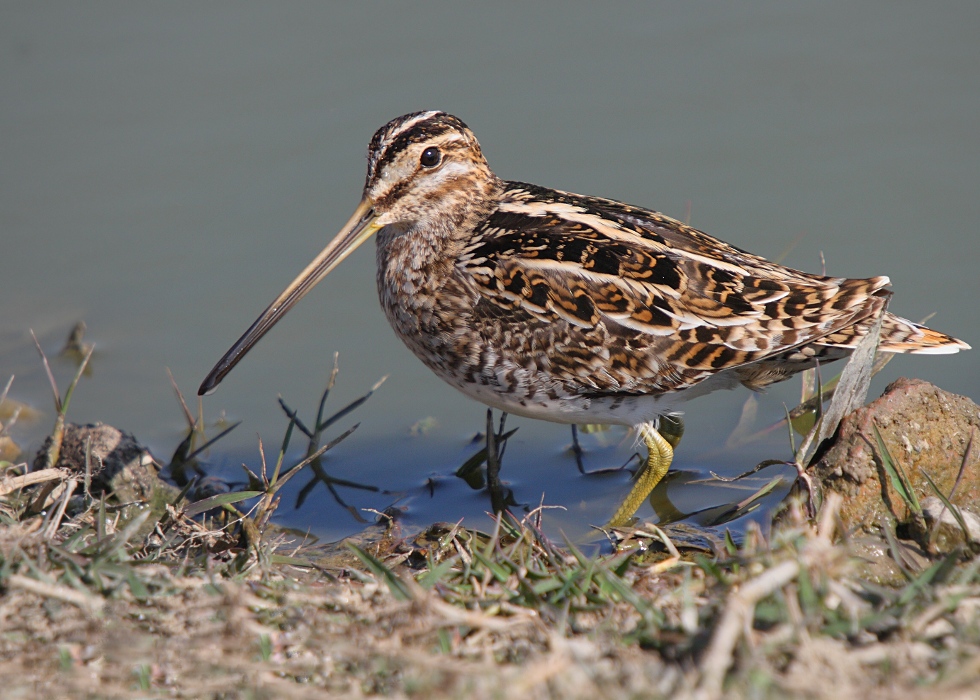| Kingdom: Animalia Phylum: Chordata Class: Aves (Birds) Order: Charadriiformes Family: Scolopacidae |
 Common Snipe - photo © Rajiv Lather Common Snipe (Gallinago gallinago) is a widespread winter visitor and local resident in India. Size: 26 cm Common Snipe are stocky, long-billed inland sandpipers of moist woodlands, marshes and riverbanks. Widespread yet inconspicuous, these secretive, wading birds display cryptic plumage and are usually so well concealed that they are not detected until flushed! Their common name, "snipe" (meaning "to shoot from a concealed place"), may be derived from their explosive, noisy behavior when flushed. Adept aerialists, Common Snipe fly high and fast, often zigzagging and twisting through the sky. During flight displays ("winnowing"), these birds circle high and suddenly dive with outspread outer tail feathers, producing a characteristic low and pulsating whistle. Identification: Usually solitary and secretive, Common Snipe dwell among muddy habitats at the edges of shallow ponds, streambeds and riverbanks where vegetation provides sufficient cover. They are also common in wet tundra habitats. These medium-sized, chunky birds are short-legged, short-necked and short-winged with extremely long, straight, gray bills. The plumage of breeding adults is cryptically patterned in browns and black, with bold white stripes along the heads and backs. Two buffy lines, one above and one below each eye, highlight the face. Dark barring underneath the wings and on the flanks offsets the solid-white belly. Bright-orange feathers accent the tips of their tails and are particularly conspicuous during flight. Juveniles strongly resemble adults but display more pronounced striping along their backs. Calls: Generally quiet, Common Snipe produce various vocalizations during the breeding season. Their flight call is a dry, harsh scraping, "scresh" or "kesh." On the nesting grounds, males deliver their display songs from conspicuous perches as loud "TIKa, TIKa, TIKa" or "kit, kit, kit, kit, kit…" notes. Winnowing flight displays are made during the breeding season, migration and in winter. The sounds produced from airflow over the outstretched tail feathers are low, hollow and quavering hoots, "whu-whu-whu-whu-whu-whu-whu…," similar to that of the Boreal Owl. Nests: Common Snipe nest in shallow ground-depressions on small clumps of grass under low vegetation. The cup-shaped nest is made of fine grasses, dead leaves and mosses and is softly lined with fine grasses. Often concealed by overhanging vegetation, the compact nest provides safe haven for the 3-4, 39 mm eggs of the clutch. The eggs are brownish-olive buff in color, marked in dark browns and frequently encircled (wreathed). Although the female alone incubates the clutch for 18-20 days, both parents actively defend the nest from intruders by performing distraction displays. Not easily flushed, the female remains on the nest until the intruder is very near. When the intruder draws too close, the female will flush from the nest in a sudden, loud burst of flight. Young birds fledge in 19-20 days post-hatching. The adults divide the brood and rear their respective groups separately. Food: The diet of the Common Snipe consists of insects, earthworms and aquatic organisms. They feed in shallow water by rapidly and vertically probing into the mud with their long, slender bills. Pliable and equipped with sensitive tips, their bills enable them to forage by feel underwater. Common Snipe drink a lot of water and produce pellets from the indigestible materials of their prey (shells, exoskeletons, etc.). |
 birding.in
birding.in
| Birds | Bird Diagram | Ornithology | Indian Sites | Bird Watching | Migration | North India | Birds of India | Haryana |
All rights reserved. Copyright © 2005-2013 Birds and birding in India. Disclaimer
website: Free Java Guide & Tutorials